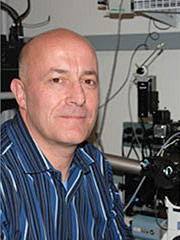
Research by scientists at the University of Pittsburgh Cancer Institute (UPCI)—including McGowan Institute for Regenerative Medicine affiliated faculty member Simon Watkins, PhD, founder and director of the Center for Biologic Imaging at the University of Pittsburgh—has revealed how cancer cells hijack DNA repair pathways to prevent telomeres, the endcaps of chromosomes, from shortening, thus allowing the tumor to spread. The findings are published in the journal Cell Reports.
The moment a cell is formed, a countdown clock starts ticking that determines how long the cell can live. The clock is the telomere, a series of repeating DNA letters at the ends of each chromosome in the cell.
However, cancer cells cleverly hijack this telomere clock, resetting it and lengthening the telomere every time it shortens. This leads the cell into thinking that it is still young and can divide, spreading the tumor.
Most cancers do this by increasing the activity of an enzyme called telomerase which lengthens telomeres. But approximately 15 percent of cancers use a different mechanism for resetting the clock, called alternative lengthening of telomeres (ALT).
Growing evidence also suggests that tumors that activate the ALT pathway are aggressive and more resistant to treatment. Although ALT was identified close to 2 decades ago, identifying how this mechanism works has proved elusive.
“Identifying the parts that the cancer cell tweaks to reset the countdown timer could provide targets for developing new cancer drugs or making existing ones more effective,” said senior author Roderick O’Sullivan, PhD, assistant professor of pharmacology and chemical biology at Pitt’s School of Medicine and a member of UPCI.
Dr. O’Sullivan and his team tackled this problem by using a recently developed technique called proximity dependent biotinylation (BioID), which allowed them to quickly identify proteins that were physically close to, and hence potentially associated with, telomere lengthening in cancer cells.
When comparing cancer cells in which either telomerase or ALT were active, the BioID technique identified 139 proteins that were unique to ALT-activated cells. As the research team took a closer look, one enzyme, DNA polymerase η (Polη), took them by surprise.
“We expected to see DNA repair proteins, but seeing Polη was really unexpected as it was known to be activated only in cells that were damaged by UV light, which we did not use in our experiments. Its role in the ALT pathway is completely independent of how we think of it normally,” said Dr. O’Sullivan. Knowing the molecular players in the ALT pathway opens up a whole new area of research and many potential drug targets, according to Dr. O’Sullivan.
Laura Garcia-Exposito, PhD, a postdoctoral fellow in Dr. O’Sullivan’s lab, and Elodie Bournique, a graduate student in the laboratory of Dr. Jean-Sébastien Hoffmann at the Cancer Research Center of Toulouse, France, are the co-first authors of the study.
Read more…
UPMC/University of Pittsburgh Schools of the Health Sciences Media Relations News Release
Abstract (Proteomic profiling reveals a specific role for translesion DNA polymerase η in the alternative lengthening of telomeres. Laura Garcia-Exposito , Elodie Bournique, Valérie Bergoglio, Arindam Bose, Jonathan Barroso-Gonzalez, Sufang Zhang, Justin L. Roncaioli, Marietta Lee, Callen T. Wallace, Simon C. Watkins, Patricia L. Opresko, Jean-Sébastien Hoffmann, Roderick J. O’Sullivan. Cell Reports; Volume 17, Issue 7, p1858–1871, 8 November 2016.)
